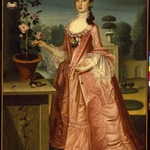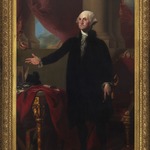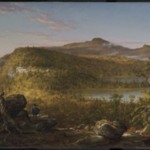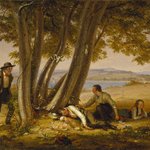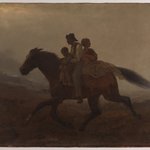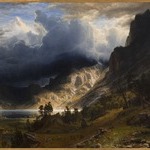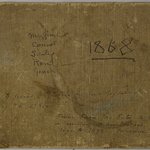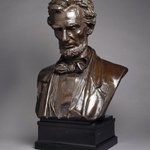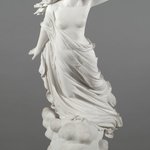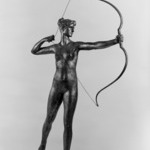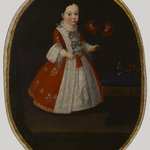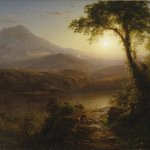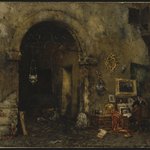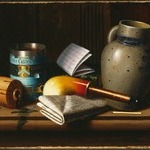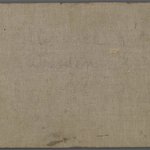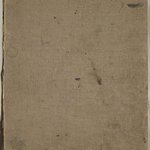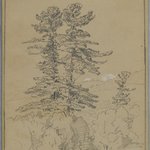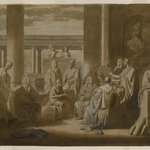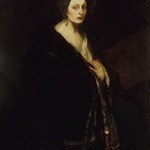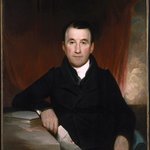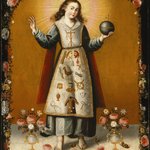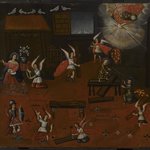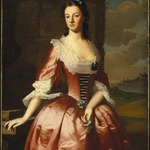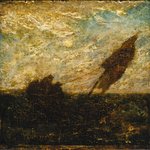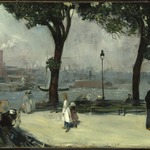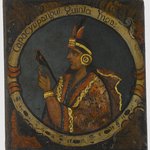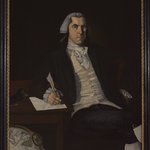Collection: American Art
HIGHLIGHTS
FULL COLLECTION
COLLECTION HISTORY
We hold one of the oldest and finest public collections of American art in the world. It was formally established in 1855 when a purchase fund bequeathed by the key Museum founder, Augustus Graham, was used to commission a landscape by Asher B. Durand. These holdings have grown to include paintings, sculptures, watercolors, pastels, drawings, and prints ranging from circa 1720 to 1945. (American art dated after 1945 is assigned to our Contemporary collection.) Highlights of the paintings collection include iconic portraits of George Washington by Gilbert Stuart and Charles Willson Peale, both from the eighteenth century, and our version of Edward Hicks's The Peaceable Kingdom (circa 1833–34).
Among the famous nineteenth-century landscape and figure painters represented are Albert Bierstadt, Frederic Church, Thomas Cole, Winslow Homer, George Inness, Eastman Johnson, William Merritt Chase, Thomas Eakins, Albert P. Ryder, and John Singer Sargent. American Impressionist masterworks include Sargent's Paul Helleu Sketching with His Wife (1889), John H. Twachtman's Meadow Flowers (circa 1892), and Childe Hassam's Late Afternoon, New York, Winter (1900). Turn-of-the-century urban realism is well represented by the works of The Eight and the Ashcan School. The collection is also strong in early modernist works, including paintings by Max Weber, Marsden Hartley, Georgia O'Keeffe, Charles Sheeler, and Stuart Davis.
Major works by Winslow Homer and Sargent make up an extensive collection of watercolors that surveys the medium over three centuries and also includes works by Edward Hopper, John Marin, Charles Burchfield, and Norman Rockwell. The artists Mary Cassatt, Robert F. Blum, Twachtman, Chase, Arthur B. Davies, and Everett Shinn are represented by works in pastel, another strong area within the American collection. Drawings range from the late eighteenth to the mid-twentieth century and include significant works by Hudson River School artists, the American Pre-Raphaelites, and Ralph Albert Blakelock. The American print holdings are particularly strong in works by Homer, artists of The Eight and the Ashcan School, and American modernists.
Highlights of the sculpture holdings are William Rush's great wood carving Winter (1810) and Hiram Powers's famed marble Greek Slave (1866), in which the mid-century Neoclassical style reached its apogee. The collection is especially rich in later nineteenth-century Beaux-Arts bronzes, including works by Augustus Saint-Gaudens, Frederic MacMonnies, and Olin Levi Warner. It includes landmark modernist works in bronze and stone by Elie Nadelman, Gaston Lachaise, and John B. Flannagan, as well as exemplary works by Malvina Hoffman and the famed African American carver William Edmondson. We also house an important collection of architectural sculpture and ornament, highlights of which are displayed outdoors in the Steinberg Family Sculpture Garden.
Many works from the American collection are displayed alongside related objects from our decorative arts, Spanish colonial, contemporary, Pre-Columbian, and Native American holdings in the Luce Center for American Art, which also includes the Luce Visible Storage ♦ Study Center, a five-thousand-square-foot facility where some two thousand objects are available for viewing, study, and enjoyment by our visitors. Works in the Luce Center for American Art are also accessible online.
Among the famous nineteenth-century landscape and figure painters represented are Albert Bierstadt, Frederic Church, Thomas Cole, Winslow Homer, George Inness, Eastman Johnson, William Merritt Chase, Thomas Eakins, Albert P. Ryder, and John Singer Sargent. American Impressionist masterworks include Sargent's Paul Helleu Sketching with His Wife (1889), John H. Twachtman's Meadow Flowers (circa 1892), and Childe Hassam's Late Afternoon, New York, Winter (1900). Turn-of-the-century urban realism is well represented by the works of The Eight and the Ashcan School. The collection is also strong in early modernist works, including paintings by Max Weber, Marsden Hartley, Georgia O'Keeffe, Charles Sheeler, and Stuart Davis.
Major works by Winslow Homer and Sargent make up an extensive collection of watercolors that surveys the medium over three centuries and also includes works by Edward Hopper, John Marin, Charles Burchfield, and Norman Rockwell. The artists Mary Cassatt, Robert F. Blum, Twachtman, Chase, Arthur B. Davies, and Everett Shinn are represented by works in pastel, another strong area within the American collection. Drawings range from the late eighteenth to the mid-twentieth century and include significant works by Hudson River School artists, the American Pre-Raphaelites, and Ralph Albert Blakelock. The American print holdings are particularly strong in works by Homer, artists of The Eight and the Ashcan School, and American modernists.
Highlights of the sculpture holdings are William Rush's great wood carving Winter (1810) and Hiram Powers's famed marble Greek Slave (1866), in which the mid-century Neoclassical style reached its apogee. The collection is especially rich in later nineteenth-century Beaux-Arts bronzes, including works by Augustus Saint-Gaudens, Frederic MacMonnies, and Olin Levi Warner. It includes landmark modernist works in bronze and stone by Elie Nadelman, Gaston Lachaise, and John B. Flannagan, as well as exemplary works by Malvina Hoffman and the famed African American carver William Edmondson. We also house an important collection of architectural sculpture and ornament, highlights of which are displayed outdoors in the Steinberg Family Sculpture Garden.
Many works from the American collection are displayed alongside related objects from our decorative arts, Spanish colonial, contemporary, Pre-Columbian, and Native American holdings in the Luce Center for American Art, which also includes the Luce Visible Storage ♦ Study Center, a five-thousand-square-foot facility where some two thousand objects are available for viewing, study, and enjoyment by our visitors. Works in the Luce Center for American Art are also accessible online.
